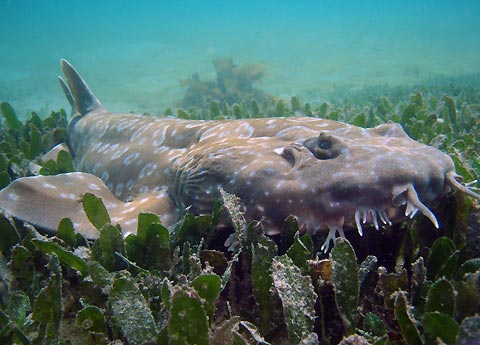You might have seen this nice little news story posted on your Facebook wall today about a shark rescued from a Taiwanese seafood restaurant and released back into the wild.
I was aware of this a good few weeks ago when Eion (the guy in the video using some rather majestic "Chinglish" to address the nation) asked for advice on what to do with this shark they had found which they wanted to release. Of course, they managed to do it in the end so well done them but this blog is more a question about the actual shark itself.
The related literature I have seen with the release of the video on social media states that the shark is a "White Spotted Bamboo Shark" which the shark in the video obviously is not...
Whitespotted Bamboo Shark
That's a White Spotted Bamboo Shark, the shark in the video is clearly a Wobbegong but which kind? My two main thoughts are...
Spotted Wobbegong
Or...
Japanese Wobbegong
The Japanese Wobbegong would make a lot more sense but since I first saw a pic, I straight away thought Spotted Wobbegong but if so, what the hell would a live Spotted Wobbegong be doing in a Taiwanese seafood restaurant?!
I'm not much of an expert on the various species of Wobbies so Mike, JSD, David Shiffman...Any of you able to shed light on exactly which species this is from the video?





8 comments:
Wobbegongs have unique colour patterns. In my opinion the one in the Video is Orectolobus wardi, The Northern Wobbegong.The only question is...how did this Specimen which is typical native only to Northern Australia get there?
I don't see a reason why this could not be japonicus - compare to picture here?
Re wardi I beg to disagree, compare e.g. the pecs with the few pictures here.
Re maculatus, I don't see the fine white lines as in here.
Thanks fellas, I'm erring towards The Japanese Wobbegong myself, it would also explain what it was doing there a lot more than if it were an Australian only Wobbie species...
Would have been good if they'd put a tag on it but hey ho.
Wud have also been good driving it to a reef habitat instead of unceremoniously dumping it into the surf!
Still, better than not releasing it at all, so well done!
I get the feeling the whole thing was a bit rushed and could have been done better, however, for the ordinary guys and gals like Eion in the video who just wanted to help and do something good, this is a nice little win and they should be given credit :)
The reason I went more for O.wardi is because japanese has smaller spots on the blotches which are not seen on the released specimen. Please take a look at the photo and Book pages I based my opinion on
here
Compare the shape of the pecs to the drawing you posted Alex.:)
wardi has very rounded pecs, also compare to the pics in the link I posted above - this shark does not.
Yes?
It is true that on some photos/drawings wardi seems to have rounder pecs, but than again in wobbegongs, pecs are not an identification issue.
O.japonicus: very obvious colour pattern of broad dorsal saddles with spots and blotches and dark (not black)corrugated edges separated by lighter areas with dark broad reticular lines. Five dermal lobes below and in front of eyes on each side of head.Long branched nasal barbels.
O.wardi: Simple sombre colour pattern. A few dark spots, dusky mottling, and 3 large dark light-edged rounded saddles separated by broad dusky areas without spots or reticular lines in front of first dorsal fin. Two dermal lobes below and in front of each eye. Dermal lobes behind spiracles unbranched and broad, unbranched nasal barbels.
Having now seen a much better video clip here , it could be we are both wrong..........
This shark does not have the dark (not black)corrugated edges of the Japanese, but also has too many barbels for a Northern!
Post a Comment